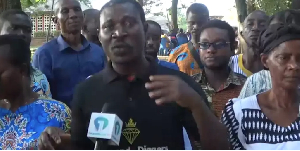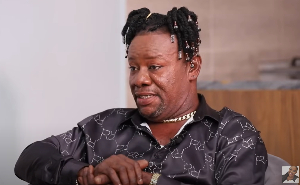Yes that is what they call themselves, Engineers, because of their education, training and experience. Ask them anything from Abraham to Zion and you would be surprised at the depth of their knowledge. They had attended the best institutions and conferences in the field. They had traveled and seen what their colleagues had done in the field for their respective countries. Yet when it comes to their own country, Ghana, they set up death traps to kill and maimed the very people whose life they were to protect. If you asked them they unashamedly tell you that it was the best option available. I am referring to the Engineers and Research Scientist at the Building and Road Research Institute (BRRI).
Like any other human institution, it is conceded that there would be some mistakes. It is the frequency and mode of response that calls into question the relevance of such institutions.
One of two examples is of concern here. During the Limann administration, (1979-1981), the bridge linking Nsawam and Adoagyiri broke down causing severe hardship to stakeholders. At that time the elected vice-president was Dr. De Graft Johnson who had spent almost all his adult/professional life as a research-scientist with BRRI. The nation expected much from the government at the time but were miserably disappointed just as the Black Stars lost to Saudi Arabia (5 – 0) in a friendly soccer match in 2007.With all the national resources at their disposal, the best our engineers came up with is what is now considered as a “bridge” over the Densu river on a national highway – an eyesore and a national disgrace. Our scientist/engineers could not come out with something longer, larger and stronger to cater for the volume of traffic that use the facility on a daily basis. They just copied what the colonial administration had done earlier. One would had no problem if the response had been as the General Afrifa-led National Liberation Council did in 1968 when torrential rains washed away the Ejisu-Besease bridge on the same highway – they provided military-style bridge within days as a temporary measure.
Second, the focus of my anger with BRRI is their response to the complaints of Kumasi residents about the four roundabouts on the newly constructed Kwame Nkrumah University of Science and Technology (KNUST) junction-Ejisu Road. This followed the growing number of vehicular accidents and the resultant casualties recorded at the roundabouts, particularly at the KNUST junction. Ghanaweb (10/4/07) reported that five persons had been killed when the trailer of an articulated truck disengaged and fell on an Urvan mini bus. The report had it that before then at least four other accidents had occurred on the same spot as the vehicles attempted to negotiate the roundabout and that another vehicle was damaged when it ran over the concrete structure.
Reacting to the concerns of the public, a research scientist of BRRI, Owusu-Tawia, said “The design is in order but that the only problem is that drivers do not have the patience to slow down on reaching the roundabouts” What a disappointment. If an engineer could not identify this human factor, patience, in road design, then wherein lies our safety? More disturbing is his statement that the Ashanti Region was the most accident prone area in the country and that with the construction of the Kumasi-Ejisu Road, there was the possibility that vehicles could speed to cause accidents on the road. Thus the engineers knew that drivers “were impatient” and “Ashanti Region was the most accident prone in the country” and yet could not address them in the design and construction of the Ejisu-KNUST-Junction Road? Our own scientists and engineers cannot solve our problems?
Very worrying is Owusu-Tawiah’s argument that in constructing roads of this nature safety measures like roundabouts, speed ramps and traffic lights were important and that with regard to the Kumasi-Ejisu Road the engineers realized that roundabouts were the best option. What the engineers and BRRI had failed to realize was the fact that their best option, roundabouts, had already claimed five lives within one year of its construction. A responsible research institution would review the design and construction and come out with something that would take into consideration concerns and characteristics of the population it was dealing with.
In other countries the perception of sickness or death related to a given facility would be enough to call for serious investigation into its cause even if it meant closure. “The second-largest beef recall in U.S. history caused Topps Meat Company LLC to go out of business. More than 21.7 million pounds of ground beef products from the company's Elizabeth, N.J. processing facility were recalled due to E. coli contamination.” (American Agriculturalist 10/5/07). The break up of bird flu in Asia caused the relocation of the Fifa Women’s World Cup from China in 2003 to the US. The Metropolitan Transportation Authority (MTA) of New York had constructed a railway to link the mainland (Jamaica Station) with the JFK Airport. On its maiden trip the train derailed and led to the death of the driver. The agency suspended operation for months until the problem was detected and fixed. All these involved millions of dollars in cost yet they believed that the lost of one life was more than too much to be risked at the expense of financial savings. Incidentally, in Ghana five people have lost their lives at a newly constructed facility, roundabout, and a research scientist from BRRI is saying that it is the best option available. Damn!
Agyaaku’s kookooase engineering at Koosekrom saved the lives of his children and others who used the main village path to and from their farms. Originally, they had a round plank over the stream for crossing over to the other side. Kids ran over the plank to cross the stream ignoring all shouts of warning. One day Adwoa fell over and in the process hit her chin on the plank. She bled through the mouth and nose. The following morning Agyaaku was the first at the place. He stopped everyone using the footpath from going to/from farm until the “bridge” was fixed. They added additional planks, flattened their tops and weeded the area to expose the facility the more to everyone. No one fell in to the stream again. At the death of the five people, one expected this type of reaction from the engineers working on the Ejisu-KNUST Junction Road
Given that Owusu-Tawiah is right about the choice of roundabout as the best option, the type chosen is not in the best interest of the customers assuming that there are different types of roundabouts. This Ghanaian research scientist of BRRI has rejected the criticism that the roundabouts were too narrow saying that if the drivers slowed down, there would be no accidents on the spots. No one would be able to get perfection so far as human behavior is concerned. The engineering aspect of the roundabout was to be taken care of so that articulators, charcoal trucks, loaded “timma cars” and all others could initiate the curve with ease. What is there right now puts much strain on such customers. When the roundabouts had not been constructed stakeholders rarely had accidents. If this is the best option then they should be taken off to avert further loss of lives.
Please someone should tell the engineers working on the Ejisu-KNUST Road that they had set up death traps for their customers and already five Ghanaians have lost their lives as a result of their “professional knowledge, expertise and experience.”



















